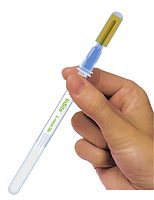On Feb. 28, 1953 Francis Crick and James Watson announced that they had discovered the basic double helix structure of DNA, a discovery which continues to shape the world around us. One colleague referred to this monumental event as “that marvelous resonance between two minds—that high state in which 1 plus 1 does not equal 2 but more like 10.” It is discoveries like these that revolutionize our world.
Within the world of pathogen detection, the combining of two different technologies such as immunomagnetic separation (IMS) and polymerase chain reaction (PCR) to create a single method has proven to be a very promising new approach. BioControl has contributed to this approach a new example of one plus one equaling 10 with Assurance GDS, a groundbreaking new pathogen detection system which uses a novel IMS method and takes advantage of the latest developments in molecular technology to deliver an unprecedented level of accuracy and speed.
IMS is the use of paramagnetic particles coated with specific antibodies to capture and separate cells containing the target antigen from the surrounding environment (sample). This technique has been widely used by microbiologists to aide in the isolation and recovery of low levels of pathogenic organisms from problematic sample matrices and high background microflora environments. It can provide additional advantages when utilized in preparation of samples for PCR-based path-ogen detection. However, not all IMS procedures are equally effective.
Conventional IMS procedures require the application of an external magnet to the outside of a thin wall tube to draw the particles through the liquid. The magnet holds the particles in place against the tube wall, the supernatant is removed, and a series of wash solutions are administered. Finally, the magnet is removed, allowing the particles to be collected and transferred for analysis.
In contrast to conventional IMS procedures, Assurance GDS™ utilizes a novel intrasolution IMS method to prepare samples for analysis via PCR. In this method, the sample aliquot and particles are combined in a deep well plate. The magnetic tips of the Assurance GDS PickPen™ device are inserted directly into the wells to collect the particles and transfer them through a wash solution into a resuspension buffer. Once deposited in the buffer, the particles and the associated captured organisms are ready for analysis with the Assurance GDS system.
Researchers at the U.S. Department of Agriculture, Meat Animal Research Center recently compared the effectiveness of the PickPen and conventional IMS procedures for recovery and detection of E. coli O157:H7 and Salmonella.[1] They concluded that conventional IMS was labor intensive and not amenable to high sample throughput. The stationary nature of the external magnet did not appear to sufficiently hold particles during wash steps leading to variability in bead recovery from the samples and the carryover of high amounts of non-target background microflora. In contrast, the intrasolution collection of particles using the PickPen produced more consistent bead recovery and significantly less carryover of background microflora. Additionally, the PickPen’s 8-channel design and ease of use made it ideal for high volume throughput, increasing the procedure’s speed without compromising sensitivity.
PickPen IMS Plus PCR
When paired with the powerful analytical capabilities of PCR the PickPen IMS technology produces a variety of additional advantages. A common approach to preventing PCR inhibition caused by certain sample matrices and enrichment media involves diluting a very small portion of the enriched sample. Unfortunately, this process also dilutes the amount of target pathogen DNA provided to the PCR reaction, requiring longer enrichment times to allow sufficient bacterial growth to compensate for this decrease in sensitivity.
In contrast, the Assurance GDS procedure removes PCR inhibitors while selectively increasing the quantity of target DNA provided to the PCR reaction. The PickPen captures the particles and physically removes them from the sample enrichment reducing the impact of potential inhibitors. Additionally, this procedure concentrates the target pathogen onto the particles allowing for the analysis of a much larger test portion than dilution protocols (1,000 µL vs. 5 µL). The combined effect of the increased sample volume and concentrated DNA results in easy single-step enrichment protocols requiring as few as 6 hours. The Assurance GDS protocol generates a high purity sample with minimal background microflora and potential PCR inhibitors without compromising sensitivity.
The benefits of PickPen IMS combined with the dual specificity of the Assurance GDS DNA primers and probes, and the innovative rotary format thermocycler result in a pathogen detection system that offers unparallel speed and accuracy. Assurance GDS is currently used in a variety of industrial and commercial testing labs for the detection of E. coli O157:H7; Shiga toxin genes; Salmonella; Listeria spp. and L. monocytogenes.
www.biocontrolsys.com
References
1. Nou, X., et al (2006). Improvement of immunomagnetic separation for Escherichia coli O157:H7 detection by the PickPen Magnetic Particle Separation Device. J. Food Prot., 69(12), 2870-2874.




